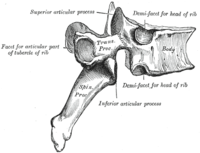
Photo from wikipedia
The management of cervical facet dislocation injuries remains controversial. The main purpose of this investigation was to identify whether a surgeon’s geographic location or years in practice influences their preferred… Click to show full abstract
The management of cervical facet dislocation injuries remains controversial. The main purpose of this investigation was to identify whether a surgeon’s geographic location or years in practice influences their preferred management of traumatic cervical facet dislocation injuries. A survey was sent to 272 AO Spine members across all geographic regions and with a variety of practice experience. The survey included clinical case scenarios of cervical facet dislocation injuries and asked responders to select preferences among various diagnostic and management options. A total of 189 complete responses were received. Over 50% of responding surgeons in each region elected to initiate management of cervical facet dislocation injuries with an MRI, with 6 case exceptions. Overall, there was considerable agreement between American and European responders regarding management of these injuries, with only 3 cases exhibiting a significant difference. Additionally, results also exhibited considerable management agreement between those with ≤ 10 and > 10 years of practice experience, with only 2 case exceptions noted. More than half of responders, regardless of geographical location or practice experience, identified MRI as a screening imaging modality when managing cervical facet dislocation injuries, regardless of the status of the spinal cord and prior to any additional intervention. Additionally, a majority of surgeons would elect an anterior approach for the surgical management of these injuries. The study found overall agreement in management preferences of cervical facet dislocation injuries around the globe.
Journal Title: European Spine Journal
Year Published: 2020
Link to full text (if available)
Share on Social Media: Sign Up to like & get
recommendations!